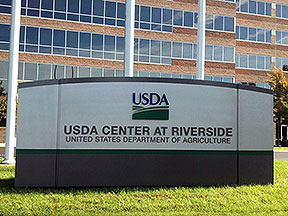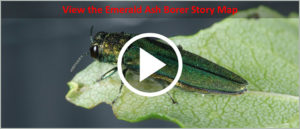APHIS’ headquarters building
USDA APHIS released its Strategic Plan for fiscal years 2019-2023 just after Thanksgiving. The report is 21 pages long. There is no evidence that any stakeholders were asked for input or review.
The Plan has a disappointing – but not surprising – emphasis on deregulation and “customer service”. A second – and more surprising weakness is the lack of attention to plant pests – even those of agriculture, much less natural resources. The emphasis is clearly on animal pests and diseases – including zoonotics.
APHIS’ mission is “To safeguard the health, welfare and value of American agricultural and natural resources.” To accomplish this mission, APHIS has set three goals:
- Deliver efficient, effective, and responsive programs.
- Safeguard American agriculture.
- Facilitate safe U.S. agricultural exports.
Most references to protecting natural resources relate to finding more environmentally sensitive approaches for the program under which APHIS reduces human-wildlife conflicts (e.g., birds being struck by airplanes).
In the Plan, APHIS Administer Kevin Shea writes in his opening message that achieving APHIS’ difficult mission of protecting the health and value of America’s agriculture and natural resources cannot be accomplished by APHIS alone. Instead, the agency must work collaboratively with other government agencies and industry, and consult regularly with partners and stakeholders regarding programs’ effectiveness. Administer Shea also highlights the importance of “delivering our programs and services efficiently, effectively, with integrity, …” The agency promises to modernize information technology, data management, methods of communication with collaborators, exporters and importers, etc., in order to give good return on expenditure of taxpayer resources. APHIS also pledges to make decisions based on science. There are seven references to basing decisions on scientific data.
Fair enough. Such emphases were to be expected from Trump Administration and prefigured by USDA Secretary Sonny Perdue during his nomination hearing, e.g., facilitating exports, supporting better information technology.
However, the Plan refers to “customer service” or “customer experience” 34 times. An additional seven references are made to reducing regulatory burdens. The Plan also speaks of the need to “protect the health, welfare, and value of American agriculture and natural resources. … at a reasonable cost. … Easing regulatory burdens makes it easier to create jobs and promote economic growth.” (Emphasis added.)
Perhaps the recent proposal to deregulate the emerald ash borer is driven in part by the emphasis on minimizing costs to regulated industries and seeking alternative approaches? (Although the deregulation has been under discussion for several years, predating the Trump Administration.)
from APHIS PPQ website
The imbalance in attention to animal versus plant pests and disease is striking. Each of the 14 goals is supported by a number of specific tactics. There are a total of 100 “tactics” under the two goals most directly relevant to preventing or managing pest introductions. These goals are: “Protecting America’s agriculture” and “Promoting U.S. agricultural exports.” Of the 100 tactics, only ten are clearly related to plant pests; 19 are pretty clearly activities that apply to both plant and animal pests and diseases; and five are unclear as to whether they include plant pests as well as animal diseases. Thus, only a third of the tactics apply!
[In making this calculation, I did not include 43 tactics listed under the first goal (“Deliver efficient, effective, and responsive programs”) or three objectives under the goal of “Protecting American agriculture” that apply explicitly to wildlife management, regulating genetically engineered organisms, or ensuring humane treatment of animals.]
Specific examples of such lack of balance include the six examples illustrating the declaration (on p. 4) that “Pest and disease events are more frequent, more complex, and less predictable.” Five of the examples are animal diseases, the sixth is the insect-vectored human disease caused by the Zika virus.
In discussing its efforts to balance its safeguarding efforts against increasing requests for market access by international trading partners, APHIS mentions some activities pertinent to plant as well as animal pest management, e.g., examining disease and pest risks and inserting mitigation strategies into international agreements and interstate movement protocols. However, the only specific action it mentions is helping countries to build capacity to implement the Global Health Security Agenda.
The only reference to forest pests is under one of the 24 tactics associated with Goal 2. Safeguard American agriculture, Objective 2.1: Prevent damaging plant and animal pests and diseases from entering and spreading in the United States to promote plant and animal health. This tactic calls for strengthening the North American perimeter against pest threats from outside the region to prevent introduction of agricultural, forest, and other invasive pests.
Why are Plant Pests slighted?
Perhaps plant-related efforts were left out because they are less “sexy”? Or because they are more distantly linked to human health? The Plan does state that “The tactics in this plan represent only a portion of APHIS activities and by no means embody all the important work APHIS does to fulfill its mission.”
Who knows what was left out?
How will adoption of this strategy affect future efforts to address tree-killing insects and pathogens – both those already present in the country and those yet to be introduced?
Might PPQ Fill in the Gaps?
In 2014 APHIS Plant Protection and Quarantine issued its own strategic plan. This supplementary plan made frequent mentions of safeguarding natural resources. Indeed, the third of the plan’s seven goals stated:
Goal 3: Protect forests, urban landscapes, rangelands and other natural resources, as well as private working lands from harmful pests and diseases
Several “tactics” under each goal also directly applied to protecting natural resources. I list them below:
1) Prevent the entry and spread of ag pests and diseases.
- Coordinate with Canada to implement an effective multi-national system that reduces the threat of tree pests arriving from Asia and other parts of the world (e.g. AGM).
3: Protect forests, urban landscapes, rangelands and other natural resources, as well as private working lands from harmful pests and diseases
- Maintain EAB regulatory framework to focus on the leading edge of infestations while minimizing impacts on regulated businesses in quarantined areas.
- Evaluate the effectiveness of biocontrol releases in states and combining both regulatory & outreach activities to address the risks of moving logs, firewood, and nursery stock.
- Examine detection technologies and partnering with states to determine and apply the most effective strategies to survey & eradicate the Asian longhorned beetle
- Partnering with federal and state agencies to enact measures such as a public outreach campaign to mitigate the movement of forest pests through firewood.
- Ensure the safe trade of ag products, creating export opportunities for U.S. producers
- play a leadership role in revising ISPM#15
- Protect the health of U.S. agricultural resources, including addressing zoonotic disease issues and incidences, by implementing surveillance, preparedness and response, and control programs
- Strengthen partnerships with Tribal Nations to develop a robust surveillance and early detection system for detecting and reporting invasive species.
- Work with all stakeholders to coordinate all-hazards agriculture and natural resources response support.
- Develop science-based programs in collaboration with industry and academia to jointly identify practices that will mitigate pest damage. E.G., SANC program http://sanc.nationalplantboard.org/ [a Systems Approach to Nursery Certification] implemented jointly with the National Plant Board and nursery industry
Dare we hope that PPQ adopts an updated strategic plan that fills in some of the gaps in the overall APHIS plan?
Posted by Faith Campbell
We welcome comments that supplement or correct factual information, suggest new approaches, or promote thoughtful consideration. We post comments that disagree with us — but not those we judge to be not civil or inflammatory.

